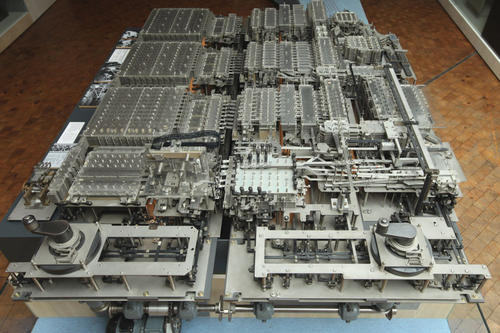Big Ideas, Re-sorted
The estate of the inventor Konrad Zuse is being digitized by scholars from Freie Universität and the Deutsches Museum in Munich.
Oct 04, 2012
Model of the Z1 computer, currently in the German Museum of Technology in Berlin
Image Credit: Julian Röder
It wasn’t an especially good report card. A few subjects were marked “Sufficient,” and even worse, there was a “Deficient” in math. That grade might have been a bit hasty in the case of the young Konrad Zuse, as arithmetic would soon come to be one of his best subjects on his way to becoming an engineer and inventor.
Konrad Zuse, born in Berlin in 1910, is considered one of the greatest pioneers in the field of computing. Recently, the digitized version of his estate was presented after two years of work by scholars from Freie Universität Berlin and employees of the archive of the Deutsches Museum, in Munich.
Schoolboy Zuse’s middling grade in penmanship turned out to be justified, though. “Zuse’s handwriting was never very legible,” says Wilhelm Füssl, who holds a doctorate in history and now heads the archive at the Deutsches Museum in Munich. Sifting through the documents and preparing the estate involved a lot of scholarly and historical detective work, not least thanks to Zuse’s handwriting.
Raúl Rojas, a professor at the Department of Mathematics and Computer Science at Freie Universität Berlin, once met Zuse in person. In 1993, at a presentation at Berlin’s Zuse Center, Rojas asked Zuse how his third and most famous computer, the Z3, worked. “Zuse just told me, ‘Read the patent application!’” Rojas says. Zuse sent him a photocopy. Rojas first had to read up on the old relay technology. But then the penny dropped, and together with one of his students, Rojas created a simulated model of the computer. That was also the start of the idea of publishing the documents, images, commentaries, and texts of the publication on the Internet – the foundation of what is now the Konrad Zuse Internet Archive.
In 2010, Freie Universität and the Deutsches Museum launched their joint digitization project. For the project, the team at the Deutsches Museum inspected and catalogued the approximately 90,000 pages in the estate for subsequent work by historians. Another part of the initial inspection, analysis, and above all technical allocation was handled by IT specialists from Freie Universität.
Organizing the estate was no simple task, as Zuse generally set his thoughts down in shorthand. The German Research Foundation (DFG) offered about 400,000 euros to have at least part of the notes transcribed into longhand. Zuse was also in the habit of writing over pages several times. Sequences of numbers initially suspected of being part of a formula later turned out to be train arrival and departure times. There are also many items in the notes that are crossed out.
The archivist from the Deutsches Museum sees the fact that the digitized documents also reflect the process by which the manuscripts were created as a big step forward. “The new chronological organization and the new considerations, some of which have been revised, offer much better insight into Konrad Zuse’s work and thinking.” Important parts of the documents in the estate are already available for free online, in the new Konrad Zuse Internet Archive. To Rojas, conserving an important part of global technical heritage is another important factor – as is affording the inventor a measure of the recognition he was long denied.
Further Information
Prof. Dr. Raúl Rojas, Freie Universität Berlin, Department of Mathematics and Computer Science, Institute of Computer Science, Intelligent Systems and Robotics Group, Tel.: +49 (0)30 / 838 75102, Email: information-ki@fu-berlin.de

